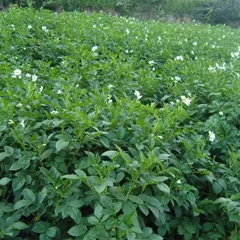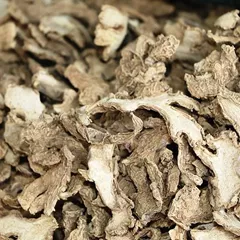Liu Yi San
Liu Yi San
Chinese: 六一散
Pinyin: Liù Yī Sàn
Other names: Six-to-One Powder


Liu Yi San
Liu Yi San
Chinese: 六一散
Pinyin: Liù Yī Sàn
Other names: Six-to-One Powder
Number of ingredients: 2 herbs
Formula category: Formulas that dispel Summer-Heat and facilitate resolution of Dampness
- Clears Summer-Heat
- Drains Dampness
- Supplements Qi
Contraindications: Contraindicated for the elderly or those with Yin Deficiency. It is also not... Contraindicated for the elderly or those with Yin Deficiency. It is also not for those without signs of Dampness. see more
Source date: 1172 AD
Source book: Formulas from the Discussion Illuminating the Yellow Emperor's Basic Questions
The information provided here is not a replacement for a doctor. You shouldn't use it for the purpose of self-diagnosing or self-medicating but rather so you can have a more informed discussion with a professional TCM practitioner.
Liu Yi San is a 2-ingredient Chinese Medicine formula with Talc (Hua Shi) as a principal ingredient.
Invented in 1172 AD, it belongs to the category of formulas that dispel Summer-Heat and facilitate resolution of Dampness. Its main actions are: 1) clears Summer-Heat and 2) drains Dampness.
On this page, after a detailed description of each of the two ingredients in Liu Yi San, we review the patterns and conditions that Liu Yi San helps treat.
The two ingredients in Liu Yi San

Hua Shi is a king ingredient in Liu Yi San. Like the name indicates, it means it has more power than other ingredients in the formula.
1. Talc (Hua Shi)
Part used: The mineral itself
Nature: Cold
Taste(s): Sweet
Meridian affinity: BladderStomach
Category: Herbs that drain Dampness
Hua Shi clears Summer-Heat and facilitates the resolution of Dampness. Its nature is heavy, and it therefore directs downward. It is also slippery and able to facilitate passage through the openings, be they the pores of the skin or the urinary orifices.

Gan Cao is a deputy ingredient in Liu Yi San. This means it helps the king ingredient(s) treat the main pattern or it serves to treat a coexisting pattern.
2. Liquorice (Gan Cao)
Part used: Dried root and rhizome
Nature: Neutral
Taste(s): Sweet
Meridian affinity: HeartLungSpleenStomach
Category: Tonic herbs for Qi Deficiency
Gan Cao harmonizes the middle and has a mild ability to clear Heat and resolve toxicity. Its combination with Talc (Hua Shi) not only promotes urination, but also generates Fluids, thereby enabling the formula to perform its tasks without injuring the Qi or body Fluids.
Conditions and patterns for which Liu Yi San may be prescribed

'Heat' as a body pattern in Chinese Medicine is one of the so-called "Eight Principles". Learn more about Heat pattern in Chinese Medicine
Summer-Heat
Pulse type(s): Rapid (Shu), Soggy (Ru)
Tongue coating: Yellow coating
Symptoms: Fever Thirst Sweating Diarrhea Vomiting Headaches Irritability Aversion to cold Urinary difficulty Feeling of heaviness Uncomfortable sensation in the epigastrium
Liu Yi San is sometimes prescribed by TCM practitioners to treat Summer-Heat. This pattern leads to symptoms such as fever, aversion to cold, sweating and headaches. Patients with Summer-Heat typically exhibit rapid (Shu) or soggy (Ru) pulses as well as Red in the front or sides with a white sticky coating.
Summer Heat is one of the four patterns of the Defensive Qi level, the first level of invasion in the Four Level theory.
It corresponds to the invasion of "External Evil" Summer-Heat. As the name indicates, it predominantly tends to occur during the summer.
As a pattern situated at the Defensive Qi... read more about Summer-Heat

The Bladder is a so-called "Fu" Organ. Learn more about the Bladder in Chinese Medicine
Damp-Heat in the Bladder
Pulse type(s): Rapid (Shu), Slippery (Hua), Wiry (Xian)
Tongue coating: Yellow coating
Symptoms: Fever Dark Urine Turbid urine Blood in urine Feeling of heat Burning urination Urinary dribbling Painful urinary dribbling Frequent and urgent urination Hypogastric fullness and pain Thirst with no desire to drink Stony painful urinary dribbling Urination stopping in the middle of flow Urine the color of rice water - grey and cloudy
Liu Yi San is sometimes prescribed by TCM practitioners to treat Damp-Heat in the Bladder. This pattern leads to symptoms such as frequent and urgent urination, burning urination, urination stopping in the middle of flow and dark urine. Patients with Damp-Heat in the Bladder typically exhibit rapid (Shu), slippery (Hua) or wiry (Xian) pulses as well as Thick sticky yellow coating on the root with red spots..
This is an Excess Heat and Dampness pattern which obstructs the smooth flow of Fluids in the Lower Burner. The obstruction gives rise to difficult urination, urgent urination and turbid urine.
The Heat causes burning and other Heat sensations.
In extreme cases, Dampness can materialize into... read more about Damp-Heat in the Bladder
Formulas similar to Liu Yi San
Bi Yu San is 67% similar to Liu Yi San
Gan Cao Gan Jiang Tang is 50% similar to Liu Yi San
Shao Yao Gan Cao Tang is 50% similar to Liu Yi San
Tiao Wei Cheng Qi Tang is 33% similar to Liu Yi San
Si Ni Tang is 33% similar to Liu Yi San
Gan Mai Da Zao Tang is 33% similar to Liu Yi San










